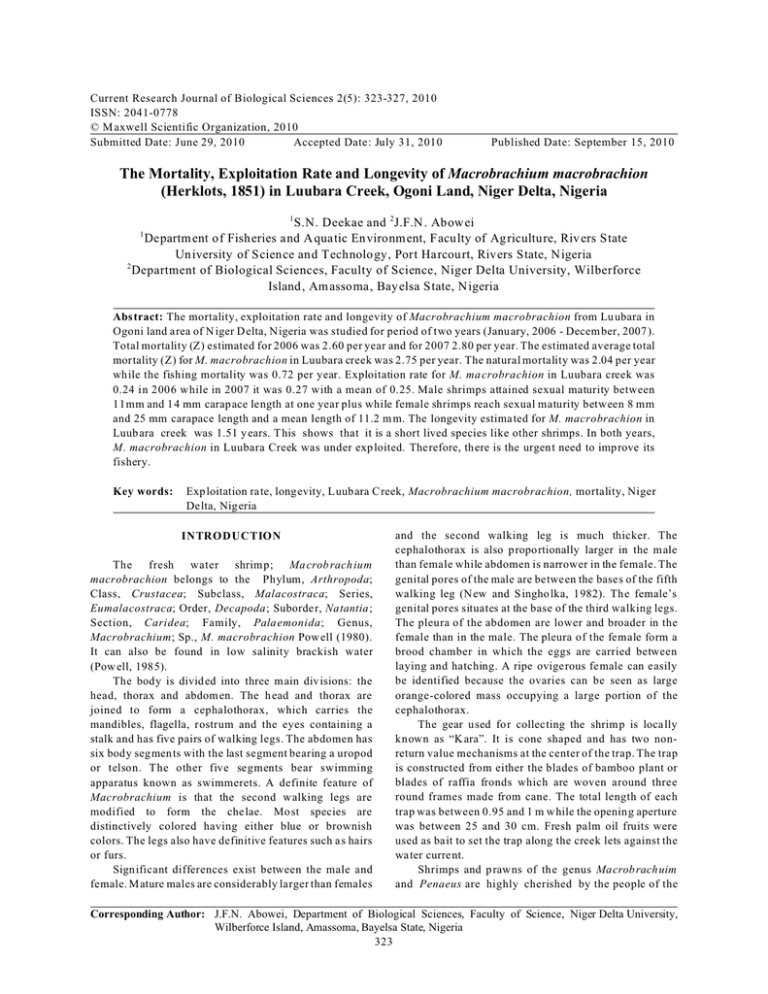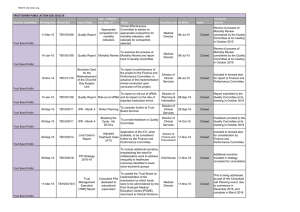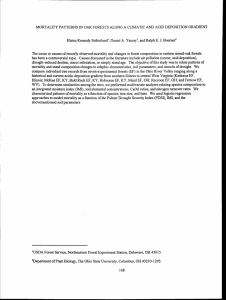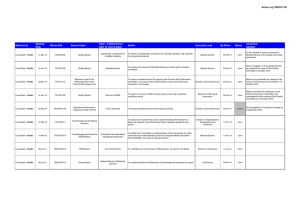Current Research Journal of Biological Sciences 2(5): 323-327, 2010 ISSN: 2041-0778
advertisement

Current Research Journal of Biological Sciences 2(5): 323-327, 2010 ISSN: 2041-0778 © M axwell Scientific Organization, 2010 Submitted Date: June 29, 2010 Accepted Date: July 31, 2010 Published Date: September 15, 2010 The Mortality, Exploitation Rate and Longevity of Macrobrachium macrobrachion (Herklots, 1851) in Luubara Creek, Ogoni Land, Niger Delta, Nigeria 1 S.N. Deekae and 2 J.F.N . Abowei Departm ent of Fisheries and A quatic Environment, Faculty of Agriculture, Riv ers State University of Science and Technolo gy, Port Harcourt, Rivers State, Nigeria 2 Department of Biological Sciences, Faculty of Science, Niger Delta University, Wilberforce Island , Am assoma, Bay elsa State, Nigeria 1 Abstract: The mortality, exploitation rate and longevity of Macrobrachium macrobrachion from Lu ubara in Ogoni land area of N iger D elta, Nigeria was studied for period of two years (January, 2006 - Decem ber, 2007). Total mortality (Z) estimated for 2006 was 2.60 per year and for 2007 2.80 per year. The estimated average total mortality (Z) for M. macrobrachion in Luubara creek was 2.75 per year. The natural mortality was 2.04 per year while the fishing mortality was 0.72 per year. Exploitation rate for M. ma crobrachion in Luubara creek was 0.24 in 2006 while in 2007 it was 0.27 with a mean of 0.25. Male shrimps attained sexual maturity between 11mm and 1 4 mm carapace length at one year plus while female shrimps reach sexual maturity between 8 mm and 25 mm carapace length and a mean length of 11.2 m m. The longevity estima ted for M. macrobrachion in Luub ara creek was 1.51 y ears. This shows that it is a short lived species like other shrimps. In both years, M. macrobrachion in Luubara Creek was under exp loited. Therefore, there is the urgent need to improve its fishery. Key words: Exp loitation rate, longevity, L uubara C reek, Macrobrachium macrobrachion, mortality, Niger Delta, Nigeria INTRODUCTION The fresh water shrimp; Ma crob rach ium macrobrachion belongs to the Phylum, Arthropoda; Class, Crustacea; Subclass, Malacostraca; Series, Eumalacostraca; Order, Decapoda; Suborder, Natantia; Section, Caridea; Family, Palaemonida; Genus, Macrobrachium; Sp., M. macrobrachion Pow ell (1980). It can also be found in low salinity brackish water (Pow ell, 1985). The body is divid ed into three m ain divisions: the head, thorax and abdom en. The h ead and thorax are joined to form a cephalothorax, which carries the mandibles, flagella, rostrum and the eyes containing a stalk and has five pairs of walking legs. The abdomen has six body segmen ts with the last segment bearing a uropod or telson. The other five segments bear swimming apparatus known as swimmerets. A definite feature of Macrobrachium is that the second walking legs are modified to form the che lae. Mo st species are distinctively colored having either blue or brownish colors. The legs also have definitive features such a s hairs or furs. Significant differences exist between the male and female. Mature males are considerably larger than females and the second walking leg is much thicker. The cephalothorax is also proportionally larger in the male than female while abdomen is narrower in the female. The genital pores of the male are between the bases of the fifth walking leg (New and S ingho lka, 1982). The female’s genital pores situates at the base of the third walking legs. The pleura of the abdomen are lower and broader in the female than in the male. The pleura of the female form a brood chamber in which the eggs are carried between laying and hatching. A ripe ovige rous female can easily be identified because the ovaries can be seen as large orange-colored mass occupying a large portion of the cephalothorax. The gear used for collecting the shrimp is loca lly known as “K ara”. It is cone shaped and has two nonreturn value mechanisms at the center of the trap. The trap is constructed from either the blades of bamboo plant or blades of raffia fronds which are woven around three round frames made from cane. The total length of each trap was between 0.95 and 1 m w hile the opening aperture was between 25 and 30 cm. Fresh palm oil fruits were used as bait to set the trap along the creek lets against the water current. Shrimps and p rawns of the genus Ma crob rach uim and Penaeus are highly cherished by the people of the Corresponding Author: J.F.N. Abowei, Department of Biological Sciences, Faculty of Science, Niger Delta University, Wilberforce Island, Amassoma, Bayelsa State, Nigeria 323 Curr. Res. J. Biol. Sci., 2(5): 323-327, 2010 Niger Delta. They are used as condimen ts in the preparation of food because of their high protein value (Umoh and Bassir, 1977; Deekae and IdoniboyeObu, 1995). They are highly priced and are in high demand in the market (Marioghae, 1990). It has been observed that there is significant reduction of the natural stock of shrim ps in our coa stal wate rs (Nw osu, 2007). This may be due to enviro nme ntal degradation w hich is detrimental to the abundance and life cycle of M. macrobrachion. Also , there are few fishers n ow to exploit the available species as a result of rural migration. The unfriendly fishing methods of local fishers who use poisons and che micals are affecting the shrimp catch. Therefore understanding the biology, environmental parame ters and population structure is essential to optimize production from the wild. The shrimp M. macrobrachion is exploited in Luubara creek R ivers State in large quantities yet there are no reports on the population biolog y of this species in the area. A study of the mortality, exploitation of Macrob rachiu m macrobrachion from Luubara creek provides base line data for management decision in the management of the species in the area and similar water bodies. Mortality can be defined as the death of an organism. It is a very important aspect of population biology since it provides information about changes in the population (Abowei and H art, 2007; Ab owe i and Hart, 2009). Mortality can be caused by fishing activity (called fishing mortality) or by natural action (natural mortality) (Abowei and Davies, 2009; Abow ei et al., 2010). Determining the cause of death of an individual shrimp is usu ally difficu lt because it is combination of physical and mental factors, therefore, we study what happens to a population of shrimps or fishes of the same age (a cohort) (King, 1995; Sparre et al., 1989). The decrease in numbers of a year class (cohort) of shrimp o r fish by death throug h time is usua lly expressed by means of exponential rates (Pauly, 198 3). The three comm only defined rates a ccord ing to Pauly (198 3) are: C Natural mortality rate denoted as M . It include s all deaths due to natural causes like predation, diseases and old age. C Fishing mortality rate denoted as F. It is death of fish or shrim p cau sed by fishing mo rtality. C Total mortality rate denoted as Z. It is the com bination of natural mortality and fishing mortality. W hen F = 0, then Z = M, Which means that the natural and total mortality are equal and there is no fishing activity (or an unexploited stock) taking place. As a cohort of shrim p increases in size, it is observed that there will be a decrease in number of survivors w ith time. T his can b e exp ressed mathema tically as: (2) Numbe r of survival after tim e (t) Original number of fish (or shrimp) 2.7128 (base of natural logarithm (a constant) Z t Instantaneous rate of total mortality Time (age - usually in units of years) = = It is a decreasing exp onential function and is therefore called, exponential decay mo del. Th ere is little work done on the mortality of shrimps in the Niger Delta. The various methods of estimating mortality of fishes can also be used for shrimps (Pauly, 1983, 1990; King, 1995). Specifically, Garcia and Reste (1981) have listed five different possible approaches for estimating the mortality rates of shrimps. These are analysis of catch curves; tagging; analysis of catch per unit effort relationship; analysis of catch vectors; virtual population and coho rt analysis and appro ximate methods. Amo ngst these methods, analysis of the catch curve seems to be used more frequently (Pauly, 1984; Sparre, 1987; Jon es and V an Zalinge , 1981; K ing, 1995). Catch curve can either be age or length based (Sparre and Venema, 1998). It is used ma inly with tropical fishes and invertebrates such as shrimps where age of individua ls is difficult to determine or where on ly length freque ncy data is available. The length frequencies that are obtained overtime are pooled together. The lengths are then converted to ages or relative age s (to) by means of a set of grow th parameters according to Sparre and Ven ema, (199 8). Exploitation rate allows for determining whether a stock is over fished or not on the assumption that the optimal value of E equals 0.5 (Pauly, 1983). A study of the mortality, exploitation rate and longevity of Macrobrachium macrobrachion from Luubara creek in Ogoni Land, Niger D elta, Nigeria; provides information for management of the species, creek , and similar water bodies and species. Pauly (198 3) stated that: Z=F+M where; N0 = Nt = e1 = (1) MATERIALS AND METHODS where; Z = Total Mortality F = Fishing Mortality M = N atural M ortality Study area: The study was carried out in Luubara in Ogoni land area of N iger D elta, Nigeria was studied for period of two years (January, 2006 - De cemb er, 2007). 324 Curr. Res. J. Biol. Sci., 2(5): 323-327, 2010 The creek is a tributary of the Imo River and is located between Longitudes 7º15 ! - 7º32 ! E and Latitudes 4º32!4º37 ! N in the Eastern part of the Niger Delta. The upper part of the creek extends from Bori and meanders through W iiyaakara, Luegbo, Duburo and joins the Imo River at Kalooko . The creek is divided into two distinct sections brackish water and freshwater. The brackish water stretch is between Bane and Kalooko while the freshwater stretch extends from Bane to Bori. The brackish water area has the normal mangrove vegetation comprising of trees such as Rhizophora racemosa, Avecenia africana, Laguncularia racemosa etc., whereas the freshwater has dense vegetation comprising of large trees, various palms and aquatic macrophytes at the low intertidal zone. In freshwater area are Cocos species, Eliasis species, Nymph ea species, L emn a species an d Raffia species. It is characterized by high amb ient temperature usua lly abou t 25.5 oC an d abo ve; high relative h umid ity which fluctuates between 60 and 95% and h igh rainfall averaging about 2500 mm (Gibo, 1988). This high rainfall often increases the volume of water in the creek hence providing good fishing opportunity for the residents. Fishing is one of the major activities going on along the creek because it is the main water route of the Khana people in O goni area of the N iger D elta. The fishes caught in the area include Chrysichthys auratus, C. nigrodigitatus, Hydroc ynus forskalii, Clarias gariepinus, Pellonula leonensis, Malapterurus, electricus, Gymnarchus niloticus, Synodontis nigri Hepsetus odoe, Hernichrom is, fasciatus, Tilapia zilli, Tilapia guine ensis, Sarotherodon melanotheron and Eleotris se negalensis and shellfish (crabs and shrimps) especially Uca tangeri Callinectes amnicola , Goniopsis pelli, Cardisoma armatum M. macrobrachion, M . vollenhoveni, M. equidens, Palaemonetes africanus, Caridina africana and Desm ocaris tripisnosa. analy sis after each day’s sampling. The species was identified by use of the keys of Powell (1980, 1982) and Holthius (19 80). For each shrimp the T otal length (the distance from the tip of the rostrum to the end of telson) and the carapace length (the distance from the base of rostrum to the first body segmen t) was measured with a Vernier caliper to the nearest 0.1mm. The shrimps were then weighed with an Ohaus balance to the nearest 0.1g. Measurem ents were taken for each monthly collection and record ed accordingly. The catch curve method (Pauly, 1983) was used in estimating the total mo rtality (Z) of the shrimps. This method involv ed plo tting the n atural log arithms of the shrimps in various age grou ps (N ) against their corresponding relative age t. Z was then obtained from the slope (b) of the descen ding part of the curve after it has been fitted with a regression line. The equation of the line was derived from the equation. logeN=a+bt (3) where; a = Intercept b = Slope t = Relative age N = Age Only those values of log eN which pertains to the age of the shrimps that were identified as fully vulnera ble to the gear were included in the calculation of the linear function. Fishing mortality co-efficient (F) was estima ted as: F =Z –M (4) where; Z = Total mortality M = Natural mortality F = Fishing mortality Natural mortality (M) w as estimated u sing Pauly’s (1980) empirical formulae using the mean temperature of Luu bara creek. Specimen sampling: The shrimp samples were collected fortnigh tly from three stations alon g the creek: nam ely W iiyaakara, Luegbo and Duburo. Selection of the stations was purposefu lly based on fishing activities, ecological zonation and accessibility of site. For each station five fishermen were engaged and three traps were used. At each station the fisher men set the three sets of traps against the water current among aquatic macrophytes and left them overnight. The traps were retrieved the following day after about twe lve ho urs correspo nding to another low tide. The shrimps collected at each station were sorted into male and fema le; females were later separated into berried (ovigerous) and non-berried (non-ovigerous). Sampling lasted for twenty-three mon ths from January 2006 to November 2007. The shrimp samples were then preserved in 4% formaldehyde and transported to the RSU ST Fish eries laboratory for log10M = 0.006-0.279 log10L 4 + 0.6543 log10 K +0.4643 log10T where; m = Natural mortality L 4 =Assymptotic length (i.e., possible length) K = G rowth co-efficient T = Mean temperature of Luubara creek Note that: Z=F+M 325 Curr. Res. J. Biol. Sci., 2(5): 323-327, 2010 Tab le 1: W here F is equal to M, it implies that there was no fishing activity and exploitation is minimal. The catch curve method has also been incorporated into the FiSAT computer programme (Gayanilo and Pauly, 1997) hence Z w as obtained throug h the comp uter packag e. Exploitation rate (E) of the shrimps was determined as suggested by Pauly (1983): Year 2006 M ale Fem ale B. F ema le Bo th Mean 2005 M ale Fem ale Bo th Mean Comb ined (6) where; F = Fishing m ortality co -efficient Z = To tal mortality co-e fficient E = Exploitation rate The total mortality (Z) and the natural mortality (m) per year w as estim ated from length converted catch curves. Estim ates of total m ortality (Z) and natural m orta lity (M ) from length converted catch curves of M. macrobrachion in Luubara creek (2006 - 2007) Z F M 1.95 2.57 1.32 4.51 2.60 0.01 0.10 0.48 1.99 0.64 1.94 2.87 0.84 2.52 1.94 2.63 2.47 5.61 2.8 2.75 0.16 1.26 1.62 0.80 0.72 2.47 1.22 3.99 2.15 2.04 Tab le 2: Sum mary of to tal mo rtality (Z) and natu ral m ortality (M) and exploitation rate of M. macrobrachion in Luubara creek (2006 - 2007) Year Z M F E 2006 2.60 1.94 0.64 0.24 2007 2.80 2.15 0.80 0.27 Average 2.75 2.04 0.72 0.25 Z = Total mortality, M = Natural mortality, F = Fishing mortality, E = Ex ploita tion ra tio RESULTS The total mortality (Z) estimated for 2006 was 2.60 per year and for 2007 2.80 per year. The estimated average total mo rtality (Z) for M. macrobrachion in Luubara creek was 2.75 per year (Table 1). The natural mortality was 2.04 per year while the fishing m ortality was 0 .72 per year. Exploitation rate for M. macrobrachion in Luubara creek was 0.24 in 2006 while in 200 7 it was 0.27 with a mean of 0.25 (Table 2). Male shrimps attained sexual maturity between 11 and 14 mm carapace length at one year plus while female shrim ps reach sexual maturity between 8 and 25 mm carapace length and a mean length of 11.2 mm. The longevity estimated for M. macrobrachion in Luubara creek was 1.51 years. This show s that it is a short lived species like other shrimps. natural and fishing mortality should be equal (E = F/Z = 0.5). There is therefore an urgent need for the development of M. ma crobrachion fishery in Lub ara creek. Enin (1995) estimated the both the total mortality (Z) and the fishing mortality (F) of M. macrobrachion in the Cross River to be 10.6 and 7.2 per year, respectively. W aribugo (2005) reported that the total mortality (Z) natural mortality (M) and fishing mortality (F) of Palaemon maculates in River Nun were 0.5, 0.01 and 0.44 per year, respectively. While Enin (1995) showed that M. macrobrachion was highly exploited in Cross River, Waribugo (2005) indicated that P. maculatus was mod erately fished in the N un rive r. CONCLUSION DISCUSSION C The estimated total mortality (Z = 2.75 per year) in this study varies with 10.6 per year obtained by Enin (1995) on M. macrobrachion. The large difference may be related to the intensive fishing activity in Cross River estuary compared to Luubara creek. The natural mortality (M) recorded in this study was 2.04 per year compared to 3.36 per year in Cross R iver (Enin, 1995) while the fishing mortality (F) was 0.72 pe r year in Luub ara creek com pared to 7.24 p er year in Cross R iver. The fishing mortality calculated for M. macrobrachion in Cross River is higher than the value for this study. This may be due to the intensive exploitation (E = 0.68) at Cross River (Enin, 1995). In Luubara creek (present study) the shrimp is under exploited (E = 0.25). This reference is based on the assumption of Gulland (1971) that in an optimally exploited stock C C C Mortality values we re gen erally small and indication of little or no interference. M. macrobrachion is a short lived species like other shrimps. M. macrobrachion in Luubara Creek is under exploited. Therefore, there is the urgent need to im prove its fishery. ACKNOWLEDGMENT W e are grateful to Go d Alm ighty for the strength, know ledge and w isdom in resea rching and w riting this article. W e also thank our numerous colleques, friends, wives and students wh ose name s are too num erous to mention here due to space but contributed immensely to the success of this work. 326 Curr. Res. J. Biol. Sci., 2(5): 323-327, 2010 New, M.B . and S. Singholka, 198 2. Freshw ater prawn farmin g: M anual for the culture of Macrobrachium rosenbergii. FAO Fisheries Tec hnical. Paper, 225, pp: 116. Nwosu, F., 2007. The Problem of By Catch Associated with Industrial Shrimping: Im plications for Inshore Demersal Fisheries in the Niger Delta. In: Zabbey, (Ed.), Small Scale Shrimp Fisheries in Nigeria. Centre for Environment, Human Rights and Rural Development (CEHR D), E leme, Rivers State CEHR D/TECH /CONSE RV/01/2007, pp: 32-48. Pauly, D., 1980. A selection of simple methods for the assessment of tropical fish stocks. FAO Fisheries Circular, 729, pp: 54. Pauly, D., 1983. Some simple methods for the assessment of tropical stocks. FAO Fisheries Technical Paper 234, pp: 52. Pauly, D., 1984. Length-converted catch curves. A powerful tool for fisheries research in the tropics. (Part II). IC LA RM Fishb yte, 2(3): 9-10. Pauly, D., 1990. Length - converted catch curves and the seasonal growth in fishes. ICLARM Fishbyte, 8(3): 33-38. Pow ell, C.B., 1980. Key to shrimps and prawns (crustracea: decapoda, natantia) of the Niger D elta Basin Development Authority Area. Consultancy Report, pp: 5. Pow ell, C.B., 1982. Fresh and brackishwater shrimps of econ omic impo rtance in the Niger Delta. Proceeding 2nd Annual Conference Fisheries Society of Nigeria. Calabar, 25-27 January, pp : 254-2 85. Pow ell, C.B., 1985. The Decapods Crustaceans of the Niger Delta. In: Wilcox, H.B.R. and C.B. Po well, (Eds.), Publication C omm ittee. University of Port Harcourt, Nigeria, pp: 226-238. Sparre, P., 1987. Computer programs for fish stock assessment. Length - based fish stock assessment for Apple 11 computers. FAO Fisheries Tec hnical Paper, 101(Suppl. 2): 218. Sparre, P., E. Ursin and S.C. Venema, 1989. Introduction to tropical fish stock assessment, Part 1. manual FAO Fisheries Tech nical Paper No. 306. 1 FAO Rome, pp: 33 7. Sparre, P. and S.C. Venema, 1998. Introduction to tropical fish stock assessment. Part 1: manual. FAO Fisheries Technical. Paper 306/1. Rev. 2, pp: 578. Umoh, I.B. and O. Bassir, 1977. Lesser known sources of protein in some Nigerian peasant diets. Food Chem ., 2: 315 -329. W aribugo, S.A., 2005. Aspects of the biology and fisheries of some palaemonid shrimps in River Nun Estuary, Bayelsa State, Nigeria. M.Sc. Thesis, Rivers State University of Science and Technology, Port Harcourt, pp: 60. REFERENCES Abowei, J.F.N. and A.I. Hart, 2007. Size composition, age, mortality and ex ploitation rate of Chrysichthys nigrodigitatus from Nun river, Niger Delta, Nigeria. Afr. J. Appl. Zool. Environ. Biol., 9: 44-50. Abowei, J.F.N. and A.I. Hart, 2009. Some morp horm etric parame ters of ten finfish species from the lower Nun River, Niger Delta, Nigeria. R es. J. Biol. Sci., 4(3): 282-288. Abowei, J.F.N. and O.A. Davies, 2009. Age, Growth, mortality and condition factor of Gnathonemus tamandua (Gunther, 1862) from the fresh water reaches of the lower Nun River, Niger Delta, Nigeria. Curr. Res. J. Biol. Sci., 1(1): 28-34. Abowei, J.F.N., A.D.I. George and O.A. Davies, 2010. Mortality, Exploitation rate and Recruitm ent pattern of Callinectes a mnic ola (De Rochebrune, 1883) from Okpoka Creek, Niger Delta, Nigeria. Asian J. A ppl., 2(1): 27-34. Deekae, S.N. and T.I.E. Idoniboye-Obu, 1995. Some aspects of commercially important molluscs and crabs of the N iger Delta, Nigeria. Environ. Ecol., 13(1): 136-142. Enin, U.I., 1995. First estimates of growth, mortality and recruitment parameters of Macro brac hiu m macrobrachion Herklots, 1851 in the Cross River Estuary, Nigeria. Dana, 2(1): 29 -38. Garcia, S. and L. Reste, 1981. Life cycles, dynamics, exploitation and m anag eme nt of coastal peneid shrimp stocks. FAO Fisheries Technical Paper No. 203, pp: 215. Gayanilo, F.C. and D. Pauly, 1997. FAO-ICLA RM Stock Assessment Tools (FiSAT). FAO C omputerised Information Series (fisheries) No. 8, Rome, pp: 262. Gibo, A.E., 1988. Relationship between rainfall trends and flooding in the Niger-Benue R iver basin. J. Meteoro l., 13: 13 2-133. Gulland, J.A., 1971. The Fish Resources of the Ocean. Revised Edn., Fishing News (Bo oks) Ltd., for FAO, Rome, Survey, pp: 255. Holthius, L.B., 1980. Shrimps and prawns of the world: an annotated catalogue of species of interest to fisheries. FAO Fish. Synop., 125: 271. Jones, R. and N.P. Van Zalinge, 1981. Estimates of mortality rate and population. Size of shrimp in Kuwait waters. Kuwait Bull. Mar. Sci., 2: 273-288. King, M.G., 1995. Fisheries Biology, Assessment and Manag eme nt. Fishing News B ooks, Surrey, pp: 336. Marioghae, I.E., 1990. Studies of fishing methods, gear and marketing of Macrobrachium in the Lagos Area. Nigerian Institute of Oceanography and Marine Research Technical Paper, N o. 53, pp: 20. 327






